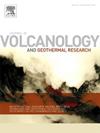The influence of FeTi oxide microlites on bubble nucleation in rhyolitic melts
IF 2.4
3区 地球科学
Q2 GEOSCIENCES, MULTIDISCIPLINARY
Journal of Volcanology and Geothermal Research
Pub Date : 2024-11-08
DOI:10.1016/j.jvolgeores.2024.108218
引用次数: 0
Abstract
We conducted a set of high-temperature decompression experiments to constrain the mechanisms of heterogeneous bubble nucleation in high-silica rhyolitic melt that contained 4.6–4.8 wt% H2O. The melt was seeded with two different size fractions of magnetite crystals: 1–2 μm crystals and large crystals of 32–135 μm (long axis). The number density of bubbles (BND) that nucleated on the small crystals was found to increase from 106.5 to 108.7 cm−3 as H2O increasingly supersaturated (ΔP) in the melt from 3 to 23 MPa. At ΔP >23 MPs, however, the number of bubbles nucleated equals the number of small magnetite and no more nucleated with increased ΔP. At the same conditions, the number of bubbles that nucleated on the large crystals increases, from <1 bubble per crystal at ΔP = 3 MPa to 14 ± 4 bubbles per crystal at 58 MPa. We thus find that ΔP has a significant influence on the mechanisms of heterogenous nucleation, but the observed increases in BND are much greater than would be predicted solely from the increase in ΔP. The discrepancy can be reconciled if there are different sites on the crystals that become activated at greater ΔP, leading to greater numbers of bubbles nucleating. The cumulative BND nucleated on small crystals, however, is capped by the number of crystals present. The BND values generated at ΔP >23 MPa in our experiments overlap with those found in ∼80 % of naturally occurring pumice. Assuming our experiments are representative of natural pumice, this suggests that explosively erupted magmas either become significantly volatile supersaturated before heterogeneously nucleating bubbles, or that the number of nucleation sites in natural magmas greatly exceed 109 cm−3.
氧化铁钛微晶对流纹岩熔体中气泡成核的影响
我们进行了一组高温减压实验,以确定含 4.6-4.8 wt% H2O 的高硅质流纹岩熔体中的异质气泡成核机制。熔体中加入了两种不同尺寸的磁铁矿晶体:1-2 μm 的晶体和 32-135 μm 的大晶体(长轴)。随着 H2O 在熔体中的过饱和度(ΔP)从 3 兆帕增加到 23 兆帕,在小晶体上成核的气泡密度(BND)从 106.5 厘米-3 增加到 108.7 厘米-3。然而,在 ΔP >23 MPs 时,成核气泡的数量等于小磁铁矿的数量,随着 ΔP 的增加,成核气泡的数量不再增加。在相同条件下,在大晶体上成核的气泡数量增加,从 ΔP = 3 MPa 时的每个晶体 1 个气泡增加到 58 MPa 时的每个晶体 14 ± 4 个气泡。因此,我们发现ΔP 对异质成核机制有重大影响,但观察到的 BND 的增加远大于仅凭 ΔP 的增加所预测的结果。如果晶体上有不同的位点在ΔP增大时被激活,从而导致更多气泡成核,那么这种差异是可以调和的。不过,在小晶体上成核的累积 BND 值受到晶体数量的限制。在我们的实验中,在 ΔP >23 兆帕时产生的 BND 值与天然浮石中 80% 的 BND 值相吻合。假设我们的实验对天然浮石具有代表性,这表明爆炸喷发的岩浆要么在异质成核气泡之前就已显著挥发过饱和,要么天然岩浆中的成核点数量大大超过 109 cm-3。
本文章由计算机程序翻译,如有差异,请以英文原文为准。
求助全文
约1分钟内获得全文
求助全文
来源期刊
CiteScore
5.90
自引率
13.80%
发文量
183
审稿时长
19.7 weeks
期刊介绍:
An international research journal with focus on volcanic and geothermal processes and their impact on the environment and society.
Submission of papers covering the following aspects of volcanology and geothermal research are encouraged:
(1) Geological aspects of volcanic systems: volcano stratigraphy, structure and tectonic influence; eruptive history; evolution of volcanic landforms; eruption style and progress; dispersal patterns of lava and ash; analysis of real-time eruption observations.
(2) Geochemical and petrological aspects of volcanic rocks: magma genesis and evolution; crystallization; volatile compositions, solubility, and degassing; volcanic petrography and textural analysis.
(3) Hydrology, geochemistry and measurement of volcanic and hydrothermal fluids: volcanic gas emissions; fumaroles and springs; crater lakes; hydrothermal mineralization.
(4) Geophysical aspects of volcanic systems: physical properties of volcanic rocks and magmas; heat flow studies; volcano seismology, geodesy and remote sensing.
(5) Computational modeling and experimental simulation of magmatic and hydrothermal processes: eruption dynamics; magma transport and storage; plume dynamics and ash dispersal; lava flow dynamics; hydrothermal fluid flow; thermodynamics of aqueous fluids and melts.
(6) Volcano hazard and risk research: hazard zonation methodology, development of forecasting tools; assessment techniques for vulnerability and impact.

 求助内容:
求助内容: 应助结果提醒方式:
应助结果提醒方式:


